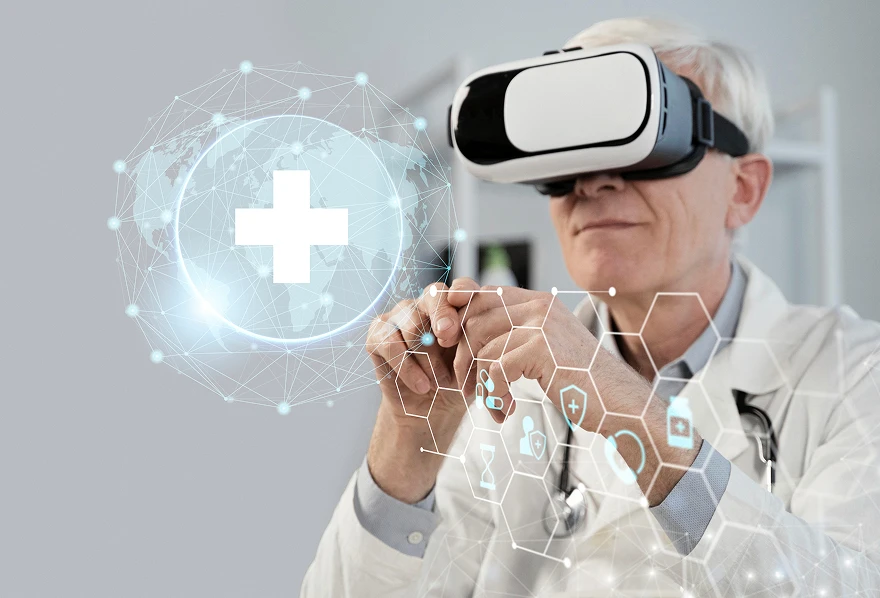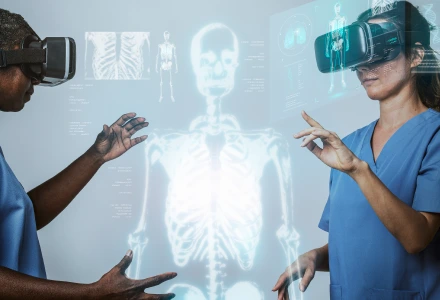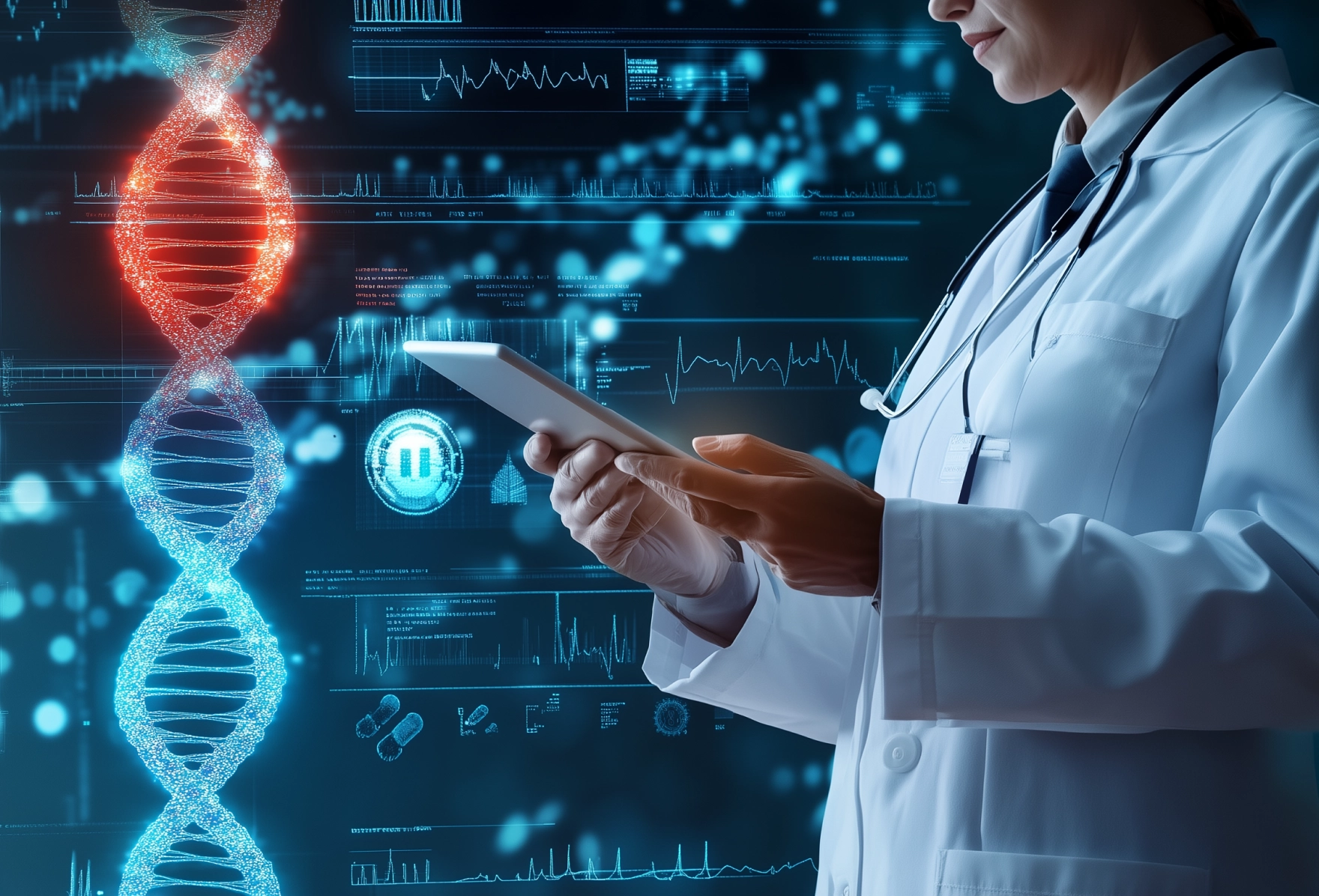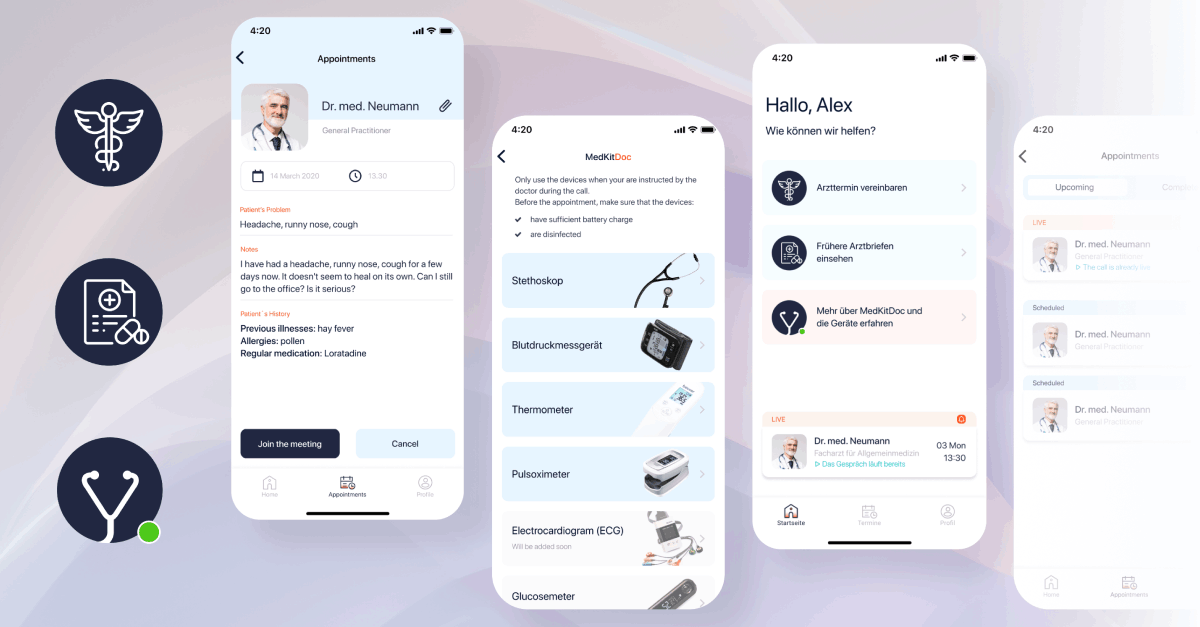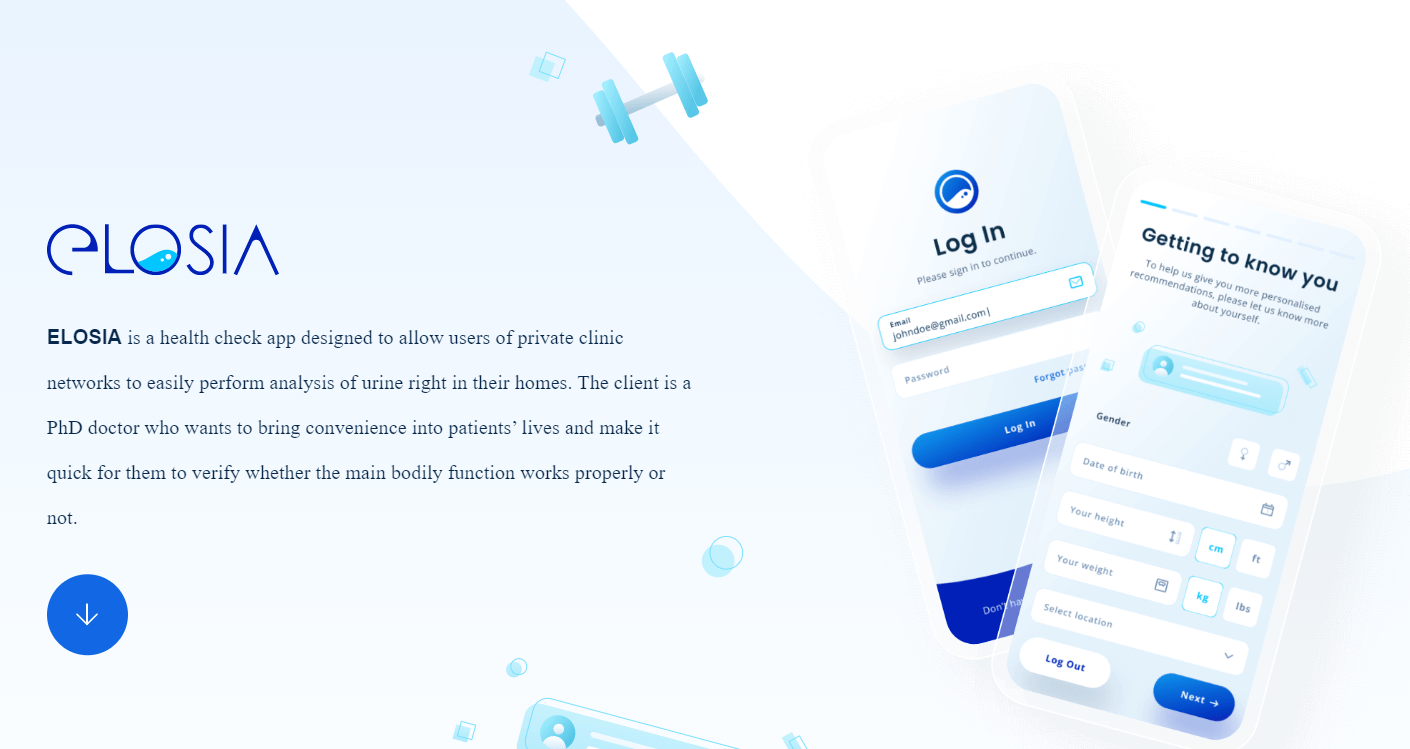IoT for medical devices is used for diagnostics, care delivery, disease treatment, and prevention. Among many numbers, IoT proves its effectiveness in the medical domain; its key goal is to reduce unnecessary clinic visits (by 25% and hospital stay by 33%). It also reduces operational costs and saves healthcare staff time for emergency visits.
 $166.5 Billion
$166.5 Billion
IoT medical devices market is projected to reach $166.5 billion by 2028.
 17.96%
17.96%
The global telemedicine market size is forecast to grow at a CAGR of 17.96% from 2024 to 2030.
 18.74%
18.74%
The IoT medical devices market is suggested to grow at a CAGR of 18.74% from 2025 to 2030.
IoT for Medical Devices | Key Functions Divided by Users
IoT for medical devices should work seamlessly without bottlenecks, offering a comprehensive overview of patient health at any given time – based on the purpose of the device itself:
-
IoT for Patients
- Devices in the form of wearables, such as blood pressure bands, fitness bands, heart rate monitoring cuffs, and glucometer.
- Wearable devices tuned to remind exercise check, calorie intake count, doctor appointments, blood pressure variations, and more.
-
IoT for Physicians
- Physicians are able to keep track of patients effectively.
- Ability to track patients’ adherence to treatment
- Ability to track any need for immediate medical attention.
- Enable healthcare professionals to be more proactive in terms of predictive analysis.
- Use data faster, set an accurate diagnosis, and reach the expected outcomes.
-
IoT for Hospitals
- Track the real-time location of medical equipment like defibrillators, nebulizers, and oxygen pumps through IoT devices tagged with sensors.
- Real-time tracking of medical staff at different locations.
- Prevent patients from getting infected through IoT-enabled hygiene monitoring devices. Improve asset management, including pharmacy inventory control, checking refrigerator temperature, as well as humidity control.
-
IoT for Health Insurance Companies
- Leverage data via health monitoring devices for their underwriting and claims operations. Using data to detect fraud claims and identify prospects for underwriting.
- Bring greater transparency between customers and insurance companies in the underwriting, claims handling, and pricing.
- Grant customers adequate visibility into the underlying thought behind every decision and process outcome.
- In the light of IoT-captured data-driven decisions in all operation processes, customers will have adequate visibility into the underlying thought behind every decision made and process outcome.
- Offer customers incentives for using and/or sharing health data collected by IoT devices. Allow insurance to validate claims using the data collected by IoT devices.
How Can IoT be Used to Improve the Quality of Healthcare?
Connected Devices Automatically Track Patients
One of the main problems most healthcare professionals struggle with is the lack of information regarding a patient’s health and treatment outcomes once the patient leaves the hospital. This causes another issue for patients – the need to come in for several follow-up visits just to report any new feelings, issues, side effects, or improvements to redirect or confirm a specific treatment plan.
Wearable devices resolve both these issues by making treatment much more manageable for both patients and doctors.

Americans lose about $47 billion a year seeking care in the wrong place.
For instance, some wearable devices are used to measure patient vitals, such as heart rate, blood pressure, temperature, breathing, and more. IoT devices in medical field then transfer data to nurses or healthcare professionals. In case the patient has some health problems, the device will send an alert to the person monitoring the device, preventing lethality and reducing unnecessary ER visits.
IoT Improves and Eases Patient Data Collection and Records
Wearable connected devices offer endless opportunities for collecting patient data. Let’s take as an example a patient in a smart bed — medical staff will be able to collect a large volume of useful data recorded automatically.
Electronic records collected from IoT wearable medical devices also help nurses since they reduce the need for chasing down information on each patient. The data can later be safely stored in their electronic health record, making treatment and diagnosis easier.
Patient Health Assessments
Besides changes in patients from doctors, individuals will also be able to improve their health with accurate assessments. Some medical apps have already given patients control over their health.
There are sleep applications allowing users to monitor sleep health, maintain a circadian rhythm and monitor sleep cycles. Fitness applications connected with wearables allow users to stay in shape. Calorie intake and count software provides a tailored nutrition plan so users know what to eat and what to avoid based on their preferences and health needs.
Vaccine Delivery Optimization
IoT in the healthcare domain is also used for vaccine transport and storage. There are many vaccines that have to remain at extreme temperatures so they don’t expire. IoT sensors are an effective solution that maintains these low temperatures and informs staff in case of an issue.
In fact, there are IoT devices in vaccine shipment units that can automatically adjust the needed temperature based on real-time data, just like smart thermostats some have at home. The same sensors alter a proper employee if something happens that jeopardizes the cooling system’s integrity.
Benefits of IoT for Connected Medical Devices
Enhanced Diagnostics and Treatment
A good example of how IoT in healthcare improves diagnostics and treatment is capsule endoscopy. In contrast to uncomfortable and scary endoscopy, patients just need to swallow a pill with an integrated mini-camera taking pictures of the digestive tract.
Just like with endoscopy, pictures taken with this small capsule allow doctors to analyze the situation and make an accurate diagnosis. Healthcare professionals can also use Machine Learning here to automate picture processing to treat patients more effectively.
Customer Satisfaction
Alongside using medical devices, IoT improves customer satisfaction. That is because they are more involved in the process and have greater access to all needed information than ever before.
The connected medical infrastructure allows patients to communicate easily with clinics while also allowing doctors to monitor their health remotely and in real time. This way, patients feel more informed, reduce unnecessary visits and questions and improve overall satisfaction.
Remote Monitoring
Patients with specific treatment plans or chronic conditions benefit from remote monitoring. For instance, wearable devices monitoring glucose levels in the blood have changed the way patients with diabetes live, improving their health and reducing risks. These devices send real-time information to doctors.
Staff Monitoring and Compliance with Requirements
Hospitals are pretty busy places at any time of the day, meaning managers can’t monitor everything and everyone. IoT devices and connected software automate staff monitoring and compliance-monitoring processes. This process saves both money the clinic otherwise would spend on potential lawsuits and reduces compliance-related costs.
Open More Business Opportunities
IoT architecture opens more business opportunities. Collected data is aggregated and located in the cloud, allowing Machine Learning algorithms to examine it and provide valuable insights.
Preventive Care
Preventing care must be the key focus since it helps patients avoid severe consequences and new diseases. IoT in medical devices offers highly accurate data regarding each patient’s case, revitalizing the healthcare sector and helping patients live healthy lives by preventing severe diseases.
Overall Costs Reduction
Insurance companies increasingly rely on performance-based reimbursement of healthcare companies as healthcare costs rise. As a result, doctors have to constantly prove they can help their patients to get compensation for their care.
Clinics can reduce overall costs by furnishing IoT wearable medical devices and discharging patients from clinics much earlier. This will help doctors to monitor patients’ health and results from treatments.

IoT for Medical Devices: Adoption Challenges
-
1 Data Security and Privacy
Protecting patient data from cyber threats and ensuring patient privacy is a key concern in IoT healthcare devices. These devices are interconnected in nature, so they may increase the risk of unauthorized access and data breaches. When relying on IoT technology, clinics need to ensure proper installation of hardware and software, monitor activity, and timely conduct software updates.
-
2 Connectivity
Achieving tamperproof, seamless communication and interoperability among IoT based medical devices from different providers is a challenge. For example, ONC has already implemented steps to ensure the achievement of smooth connectivity and interoperability and make sure government incentives are in place to allow healthcare organizations to adopt EHRs. Otherwise, they will write fines to organizations that fail to implement IoT technology.
-
3 Reliability and Accuracy
Maintaining the accuracy and reliability of IoT devices in the medical sphere is critical for making data-driven clinical decisions. Factors like data transmission errors, device malfunction, and sensor calibration may impact the work of these devices. It is crucial to ensure they function the way they are supposed to, check battery life, and follow the manufacturer’s offers regarding system updates.
-
4 Cost
The adoption of new technologies always involves increasing costs. In the case of IoT medical devices, the process also involves the acquisition of devices, proper infrastructure development, and system integration. Ongoing expenses like staff training, data protection, updates, and system maintenance also affect the overall cost in the long run. Clinics should consider IoT medical devices implementation case by case, leaning on the predicted benefits and potential return on investment.
Interexy’s Expertise in IoT in Medical Devices
Interexy contributed to the Autonomous Living project, a healthcare platform designed to support caregivers and empower patients through IoT-driven remote monitoring. The solution includes mobile and web applications that enhance communication, automate daily tasks, and integrate sensor-based tracking for medication intake, meal consumption, and physical activity. Our team worked on both the frontend and backend, improving real-time communication tools using Webex by Cisco for secure video calls and chats. By leveraging IoT healthcare devices, we helped create a seamless and efficient system for patient monitoring and caregiver support.
Final Thoughts
IoT has become a crucial aspect of healthcare growth. It has brought new positions, benefits like remote medical assistance, real-time health monitoring, data analysis, and challenges preventing some clinics from scaling through IoT implementation.
Despite issues, IoT applications in the medical domain will only grow and expand, making wearables, ingestible sensors, and video pills leading technologies in preventative healthcare. Using IoT in healthcare allows clinics to reduce costs, improve patient care and promote preventative care. Having a trusted healthcare app development company in the USA by your side will reduce risks, speed up the process and result in a successful IoT ecosystem implementation.
FAQs about IoT in Healthcare Devices
-
What is IoT in medical devices?
IoT in medical devices refers to the integration of connected sensors, software, and networks to collect and transmit healthcare data in real time. These IoT healthcare devices enhance patient monitoring, improve diagnostics, and enable remote care. Internet of Things medical devices include smart insulin pumps, connected ECG monitors, and wearable health trackers that provide continuous data for better treatment decisions.
-
Are wearables considered IoT?
Yes, wearables are a key part of IoT in medical devices. Devices like smartwatches, fitness trackers, and ECG monitors collect and transmit health data, helping doctors track patient conditions in real time. These IoT healthcare devices are widely used for monitoring heart rate, blood pressure, and physical activity, making them essential tools in medical IoT device monitoring.
-
What is a remote patient monitoring system?
A remote patient monitoring system is a type of IoT in healthcare that allows healthcare providers to track patients’ vital signs and health data outside of traditional clinical settings. Using IoT medical devices, such as wearable ECG monitors or glucose sensors, doctors can monitor conditions like heart disease or diabetes in real time. These IoT in healthcare examples help reduce hospital visits, improve patient outcomes, and provide timely interventions.
-
What are 3 advantages and disadvantages of IoT?
Advantages:
- Real-time monitoring. IoT devices used in healthcare provide continuous health tracking, leading to faster diagnosis and better treatment.
- Improved patient outcomes. IoT medicine enables early detection of health issues, reducing hospital admissions and emergency visits.
- Operational efficiency. Hospitals use IoT in healthcare examples like smart inventory tracking and predictive maintenance for medical equipment.
Disadvantages:
- Security risks. Medical IoT device monitoring involves sensitive data, making it vulnerable to cyber threats.
- High implementation costs. Setting up IoT medical devices requires significant investment in infrastructure and security.
- Data overload. Managing vast amounts of data from IoT healthcare devices can be challenging for healthcare providers.

